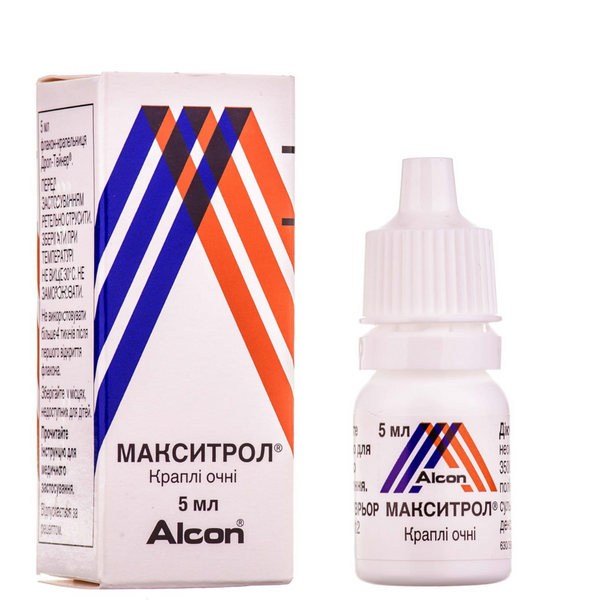|
Quantity
|
Out of stock
|
||
|
|
|||
Description
Instructions for medical use of the drug
MAXITROL®
Trade name
Maxitrol®
International nonproprietary name
No
Dosage form
Eye drops 5 ml, suspension
Composition
1 ml contains
active ingredients: dexamethasone 1 mg
neomycin sulfate 3500 U
polymyxin B sulfate 6000 U,
excipients: benzalkonium chloride (preservative), sodium chloride, polysorbate 20, hydroxypropyl methylcellulose 0.5%, hydrochloric acid and/or sodium hydroxide (to adjust pH), purified water.
Description
White suspension
Pharmacotherapeutic group
Drugs for the treatment of eye diseases. Dexamethasone in combination with antimicrobial drugs.
ATC code S01СА01
Pharmacological properties
Pharmacokinetics
Corticoids are absorbed into the aqueous humor, cornea, iris, choroid, ciliary body and retina. Systemic absorption may occur only in the case of high doses or prolonged treatment.
The maximum concentration in the aqueous humor, approximately 30 ng / ml, is achieved within two hours, which subsequently decreases over a period of half an hour to 3 hours.
The pharmacokinetics of neomycin are similar to the same aminoglycoside antibiotics. The absorption of polymyxin B sulfate through cell membranes ranges from very weak and insignificant to absolute non-penetration.
Pharmacodynamics
Dexamethasone has a pronounced anti-inflammatory, anti-allergic and desensitizing effect. Dexamethasone is a glucocorticosteroid that actively suppresses inflammatory processes by inhibiting the release of inflammatory mediators by eosinophils, migration of mast cells and reducing capillary permeability. Maxitrol® is a combination of dexamethasone in combination with antimicrobial drugs.
Neomycin is an antibiotic from the aminoglycoside group. Neomycin has a bactericidal effect, disrupting protein synthesis in the microbial cell. It has a broad spectrum of antibacterial action, is active against gram-positive and gram-negative microorganisms, including St. Aureus, Streptococcus pneumoniae, Escherichia coli, Proteus, Shigella. It is not very effective against streptococci and P. Aeruginosa. It does not act on pathogenic fungi, viruses, anaerobic flora. Microorganism resistance to neomycin develops slowly and to a small extent.
Polymyxin B is an antibiotic with a polypeptide structure. The mechanism of action is due to the ability to bind to the phospholipids of microbial cell membranes, which leads to their destruction. It is active against most gram-negative microorganisms, including Escherichia coli, Shigella, Enterobacter, Klebsiella spp., Haemophilus influenzae, Salmonella, Bordetella pertussis, especially active against P. Aeruginosa, inactive against Proteus, Nesseria spp., obligate anaerobes and gram-positive bacteria. Virbo cholerae (except for the eltor subtype) and Coccidioides immitis are sensitive to polymyxin, but fungi are mostly resistant to this antibiotic. It is one of the most active antibiotics against Pseudomonas aeruginosa. The combination of dexamethasone with antibacterial components (neomycin and polymyxin B) can reduce the risk of developing an infectious process.
Indications for use
– acute and chronic bacterial blepharitis
– conjunctivitis
– keratitis (without damage to the epithelium)
– iridocyclitis
– prevention of postoperative inflammation of the anterior segment of the eye.
Method of administration and dosage
Shake the bottle before use!
For sluggish diseases, instill 1 or 2 drops of the drug locally into the conjunctival sac every 4-6 hours. For acute diseases, drops can be used every hour, as the inflammation decreases, reduce the frequency of instillations until complete recovery. Caution should be exercised when prematurely stopping therapy. The course of treatment is determined by the attending physician.
Do not touch the tip of the pipette to the eyes or any other surface to avoid contamination of the contents of the bottle.
After instillation, it is recommended to press the nasolacrimal canal or cover the eyelids. This reduces systemic absorption and the adverse effects of the drug applied locally through the eye tissue.
When using several ophthalmic drugs for topical use, it is necessary to observe an interval of at least 5 minutes between instillations.
Side effects
– allergic reactions
– blurred vision, transient discomfort
– sensation of a foreign body in the eye
– hyperemia
– punctate keratitis
– lacrimation, itching
– swelling of the eyelids or conjunctiva
In rare cases, the following may be observed with absorption:
– increased intraocular pressure with subsequent development of glaucoma, damage to the optic nerve and visual field; formation of posterior subcapsular cataract.
– slowing down the wound healing process (in diseases causing thinning of the cornea or sclera, perforation is possible)
e fibrous membrane with local application of steroid drugs).
– development of secondary infection, fungal infection of the cornea with prolonged use of steroids.
Contraindications
– hypersensitivity to any component of the drug
– keratitis caused by the herpes pathogen
– dendritic keratitis
– cowpox
– chickenpox
– fungal eye diseases
– tuberculosis of the eyes
– uncomplicated removal of a foreign body from the cornea
– lactation period.
Drug interactions
When prescribing Maxitrol® together with other local ophthalmic drugs, it is necessary to observe an interval between instillations of at least 5 minutes.
Special instructions
When using steroids for 10 days or more, intraocular pressure should be regularly monitored and checked by the attending physician. In case of glaucoma, intraocular pressure should be checked weekly.
Long-term use of the drug may suppress the patient's immunity and thus increase the risk of secondary eye infections.
Use in pediatric practice
The safety and efficacy of the drug in children have not yet been established. The need for use of the drug in children is determined by the attending physician.
Pregnancy
Maxitrol® should only be prescribed in cases where the effectiveness of treatment justifies the possible risk to the fetus.
Contact lenses
Since Maxitrol® contains benzalkonium chloride, you should refrain from wearing soft (hydrophilic) contact lenses or remove them during instillation. Lenses can be worn between uses of the drug and inserted no earlier than 15 minutes after instillation. Maxitrol® cannot be used over contact lenses.
Features of the drug's effect on the ability to drive a vehicle or operate potentially dangerous machinery
After instillation, temporary blurred vision or other visual disturbances are possible, which may negatively affect the ability to drive a car or operate other potentially dangerous machinery. In this case, it is necessary to wait some time until vision is restored.
Overdose
Cases of overdose with this drug are not known.
Clinically determined signs or symptoms of Maxitrol® overdose (punctate keratitis, erythema, increased lacrimation, edema and itching of the eyelid) may be similar to signs of adverse reactions in some patients. In case of overdose, it is necessary to rinse the eye/eyes with plenty of warm water, with further symptomatic treatment by an ophthalmologist.
Release form and packaging
Eye drops 5 ml, suspension, in bottles made of white opaque plastic with a Drop-Tainer™ dropper-dispenser. Each bottle together with instructions for use is packed in a cardboard box.
Storage conditions
Store in an upright position at a temperature of +80 to +300C. Keep out of reach of children!
Shelf life
2 years
Do not use after the expiration date.
Shelf life after first opening is 4 weeks at a temperature of +80 to +300C.
Conditions for dispensing from pharmacies
By prescription
































